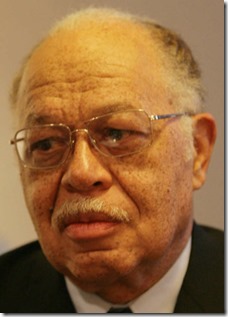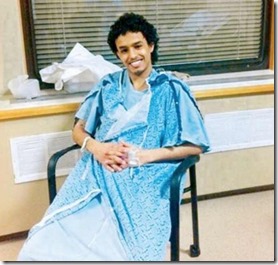“I will prescribe regimens for the good of my patients according to my ability and my judgment and never do harm to anyone. I will give no deadly medicine to any one if asked, nor suggest any such counsel; and similarly I will not give a woman a pessary to cause an abortion. But I will preserve the purity of my life and my arts. — Hippocratic Oath.
One of the big reasons the mainstream media studiously avoided covering the trial of Philadelphia abortionist Kermit Gosnell is that it doesn't like talking about the late-term abortion industry. It's a topic the media, which is heavily pro-abortion, doesn't want the public to think about. Abortion is supposed to be a quick, clean outpatient procedure, little different from having a minor skin irritation removed. The idea that more than one person is involved in this procedure is suppressed.
But it's hard to avoid that dangerous idea when discussing six-month late-term abortions, in which there is a chance the baby might emerge from the womb and survive. New videos from the pro-life undercover filmmakers at Live Action show abortion clinic doctors and staffers callously discussing ways to dispose of inconvenient born-alive infants — ranging from standing idly by and watching them die, to drowning them in jars of toxic solution, or even flushing them down toilets.
It's all so horribly dehumanizing. However divided national opinion might be on the topic of abortion, we should all be able to agree that babies born alive deserve medical assistance, and their status as people should be recognized. But then our moral calculations might begin flowing backward from that recognition, and we may wonder how the humanity of a child is completely erased simply because he rests a few inches further inside the womb. And babies much younger than 24 weeks look fully human in sonograms don't they? That's one of the reasons public opinion on abortion remains in flux, decades after a notorious Supreme Court decision that was supposed to settle the matter once and for all.
The trial of Philadelphia abortion doctor Kermit Gosnell, facing the death penalty for the deaths of four infants and one woman in his clinic, is over. America has moved on. It's exactly what the pro-abortion contingent wants. They want Gosnell out of the news because they want abortion out of the news. Ongoing discussion provokes thought about the status quo. And pro-aborts want to keep things as they are. And, they have reason to be confident.
Our president, whom no one can accuse of not being politically astute, showed up this week, despite the Gosnell story, as the first sitting president ever to address Planned Parenthood, the nation's largest abortion provider.
When Kirsten Powers brought attention to Gosnell, with her USA Today column, she said it wasn't about abortion. "This is not about being pro-choice or pro-life," she wrote. "It is about human rights." For Powers, the story was about lack of supervision. And, of course, where abortions are carried out legally, clinics should be supervised and inspected.
But to leave the story there is to be content with the tip of the iceberg. And the whole iceberg is a huge story that all of America should be looking at. The whole iceberg is bigger than abortion itself. It is about how profoundly America has changed since Roe v Wade, in 1973, made abortion an accepted part of American life.
Let's be clear that pro-aborts and pro-lifers differ on far more than technicalities about when life begins. They differ about what life is.
In the state of Pennsylvania, where Gosnell was doing his dirty business, abortion is legal until the developing child is 24 weeks — 6 months — old. Among Gosnell's many transgressions was performing abortions after 24 weeks. But Planned Parenthood, and their guest speaker, our president, oppose that 24-week limit. They believe abortion should be legal until the child is born
It should also be pointed out that in the Keystone State a 14-year old girl can walk into a Planned Parenthood abortion mill and get an abortion sans parental consent or knowledge. This same 14-year old girl would need parental consent to visit a nail salon for a manicure.
Tom Ridge, the once progressive liberal governor of Pennsylvania, signed legislation reducing the state’s inspections and regulations on abortion clinics for fear of causing higher costs to doing abortions and thus driving some of the marginal abortion clinics, like DR. Gosnell’s, out of business thus reducing the access to cheap abortions. Tom Ridge has remained silent on the Gosnell trail for obvious reasons.
In 2007, shortly after the US Supreme Court upheld the constitutionality of the Partial Birth Abortion Ban Act, which banned a brutal abortion procedure most commonly used to destroy infants from 15 to 26 weeks old, then-Senator Obama spoke at a Planned Parenthood event and decried the decision. He called it part of a "concerted effort to steadily roll back" access to abortion.
Justice Kennedy, who wrote the decision, included a description of one of these procedures on a 26-week-old infant. It takes a certain deadening of the heart, of the soul to read the description of the little baby clasping his fingers and toes as the doctor jams his scissors into his skull, and still believe this should be permitted.
Since Roe v Wade, we've given birth to a new materialistic culture of narcissism where reverence for life itself is gone. Life has become a commodity and people use each other as cavalierly as they destroy innocent young life. As our reverence for life has diminished, so has our reverence for the institutions that surround and support it.
Scholars at the Brookings Institution observed in 1996 that Roe v Wade contributed to the collapse of marriage and the dramatic increase in out-of-wedlock births. The idea that children were part of a sacred institution called marriage started disappearing. The sense of honor, the sense of shame disappears in this culture of self.
In 1965, seven years before Roe v Wade, less than 10 percent of American babies were born to unwed mothers — 24 percent to unwed black women and 3.1 percent to unwed white women. As of 2010, this was up to 41 percent of our babies born to unwed mothers — 73 percent to black women and 29 percent to white women. Sixty percent of our out-of-wedlock births are to women in their 20's.
President Obama became the first sitting president to address Planned Parenthood on Friday. Not surprisingly, he didn’t have anything to say about Kermit Gosnell, or the wave of medical emergencies at abortion clinics, or the sex-selection abortions Live Action discovered at Planned Parenthood. Obama didn’t even use the word “abortion” in his speech. Abortion is so wonderful that even the most strident abortion radical ever elected to the White House can’t bring himself to say the word.
At a time when the headline of the day is a story about the bloody massacres of babies born alive in Kermit Gosnell's clinic, the almost bone-jarring contrast of Obama's speech at Planned Parenthood freezes every normal sense of credulity in unbelief.
The story of one baby born alive in the Pennsylvania Gosnell horror mill is that the child was swimming in a toilet, trying to get out. It was pulled from the toilet only to have its spinal cord snipped while the mother was still in the room.
If the abortion industry didn’t enjoy the nearly religious devotion of the Left, it would be Occupy Wall Street’s favorite example of a big business that pays big bucks for political influence, so it can operate with ridiculously lax oversight, weak safety standards, and lavish subsidies. Kermit Gosnell preyed relentlessly upon poor black women, while treating his assistants like sweat shop labor. The excuses offered by Planned Parenthood when its staff is caught flaunting the law on undercover video are reminiscent of tobacco company executives trying to claim that smoking isn’t bad for you. The Democrat Party has expressed a willingness to shut down the entire government to protect Planned Parenthood subsidies. When a prominent charity, Susan G. Komen for the Cure, tried to decouple from Planned Parenthood, the response was straight out of “The Sopranos.” You are required to fund this organization, and you are not allowed to stop. They’ve got a lot of money, political clout, and media influence available to enforce that directive.
it would be Occupy Wall Street’s favorite example of a big business that pays big bucks for political influence, so it can operate with ridiculously lax oversight, weak safety standards, and lavish subsidies. Kermit Gosnell preyed relentlessly upon poor black women, while treating his assistants like sweat shop labor. The excuses offered by Planned Parenthood when its staff is caught flaunting the law on undercover video are reminiscent of tobacco company executives trying to claim that smoking isn’t bad for you. The Democrat Party has expressed a willingness to shut down the entire government to protect Planned Parenthood subsidies. When a prominent charity, Susan G. Komen for the Cure, tried to decouple from Planned Parenthood, the response was straight out of “The Sopranos.” You are required to fund this organization, and you are not allowed to stop. They’ve got a lot of money, political clout, and media influence available to enforce that directive.
“Planned Parenthood is not going anywhere,” Obama declared in his speech. ”It’s not going anywhere today, it’s not going anywhere tomorrow.” Well, of course not. It’s a billion-dollar corporation with $90 million annual profits that gets over $540 million in taxpayer funding that spent $12 million on highly effective political action during the last election. And really, as long as it’s a properly supervised business selling legal goods and services, there’s no reason it should “go anywhere.” It just shouldn’t be propped up with funds extracted by the government from people who don’t support its activities, especially since much of the dissenters’ money is recycled into political activity against them.
The abortion industry thrives politically by associating its politics with human identity. Opposition to Planned Parenthood is caricatured as hatred of women, even when the corporation’s critics are themselves women. That’s a neat trick, if you can pull it off: equating dissent with hatred. It’s not easy to lose a debate, if you can establish those ground rules.
And yet, the abortion lobby seems increasingly worried that they might be losing the national debate. Some of the panic is artificial, and profitable, folding neatly into the “progressive” narrative favored by the liberals who have been taking America over the edge of a cliff. ”The fact is, after decades of progress, there’s still those who want to turn back the clock to policies more suited to the 1950s than the 21st century,” warned Obama. Haven’t liberals lately been telling us that we should return to the tax policies of the Fifties, because they were prosperous despite the high nominal tax rates that nobody actually paid? Isn’t Obama’s Attorney General, Eric Holder, relentlessly determined to ensure the 21st century remains saddled with the voter identification systems of the 1950s?
But with those little spurts of nostalgia out of the way, we’re back to the “progressive” ideology that insists the failed economic policies and social degeneration of the Left are inevitable and irreversible, so any attempt to change course is “turning back the clock.” There is no reason to take this idea seriously. ”Change” can move in many different directions, including the rediscovery of ideas we might realize were abandoned in error. The modern era could be right about some things, wrong about others, and the same can be said of previous decades. Why does anyone accept the notion that the only alternative to embracing every single “progressive” failure is hopping into a time machine and returning to the days of Ozzie and Harriet? Let’s allow for the possibility that the past sixty years saw both triumphs and mistakes. We are not cursed to live with the mistakes for eternity.
There is reason for Planned Parenthood to worry about all that lovely government money drying up, as the bills come due for decades of absurd government spending. They’ll soon find themselves in a bitter war with other politically-connected dependents of a tapped-out Uncle Sam, and then all of them will be crushed together under the weight of mandatory entitlement and debt spending, which on our current course will leave nothing for either Planned Parenthood or the Pentagon within a few decades. Planned Parenthood will need all of its political weapons oiled and loaded to prevail in the arena of insolvency so this is not a good time for them to see polls that Americans are souring on abortion. They don’t seem to be in any mood to outlaw the procedure entirely — perhaps they never will be — but they’re growing uncomfortable with those late-term spinal-cord snips. They had no idea how bad things have gotten. That’s why the media thought it was so important to keep the Gosnell trial off the front pages and nightly newscasts. The really dangerous question — the one our media gatekeepers don’t want American voters asking – is: “How did this happen?” Followed inevitably by: “How often does this happen?”
Pro-lifers often wonder about the sociological damage inflicted by decades of abortion. The word “hope” gets thrown around a lot by politicians — it’s a trademark of President Obama’s — but what is more hopeless than the termination of a child’s life? How much despair can any society be expected to swallow without growing ill?
This brings me to the effect the Gosnell trial will have on the public, even with its limited media coverage.
J.D. Mullane, a reporter for the Buck’s County Courier Times has been covering the Gosnell trail since it began and written about the testimony he has heard and the lack of coverage by the media. Some of the following may be very disturbing but it makes my point. For many years people either pro-abortion or ambivalent to the issue have sat around their coffee tables sipping a glass of chardonnay or merlot talking about the benefits of abortion and the right of women to choose. Even when those pollsters call and ask you questions about abortion they are very academic in the questions. They certainly don’t ask if you are in favor of seeing the spine of 24-week old baby being cut with a pair of scissors or having its skull crashed and flushed down a toilet. If they did I am sure the polls would show a much different result for those who favor this barbaric procedure. Gosnell has brought the ugly and inhumane details of abortion to those who have closed their eyes to what happens when a woman or young girl walks into an abortion clinic.
It matters not whether Gosnell gets the death penalty or not. He is 76-years old and will spend the rest of his life behind bars and probably would die before an execution would be carried out with the appeal process as it is.
Here are a few of Mullane’s observations posted: Monday, April 15, 2013:
“It is hard to decide the most appalling images to emerge Thursday at the murder trial of Philadelphia abortion doctor Kermit Gosnell. What happened in his abortion clinic is beyond any morbid Hollywood horror.
Tiny severed feet and hands stored in jars over a sink in the “procedure” room.
Digitalis injected into the stomachs of pregnant women to stop the beating hearts of their unborn babies so that they would be born dead.
Survivor babies whose spinal cords were severed, whose brains were removed with suction, whose tiny bodies were placed in a waste bin for disposal.
Then there is commonwealth exhibit C-147, depicting a large baby balled in the fetal position, bloody, stuffed in a bin. “Big enough to walk me home,” joked Gosnell when he saw the child’s remains, testified Ashly Baldwin, a clinic employee.
Gosnell, 72, is charged with killing seven born-alive babies and causing the death of Karnamaya Mongar, 41, an immigrant from Nepal who had sought an abortion at his West Philadelphia clinic. The clinic was busy, doing brisk cash business, catering not only to local women in West Philadelphia, but also women from the affluent surrounding suburbs of Bucks and Montgomery counties. Gosnell’s reputation for no-wait abortions was so well known, women would fly in from other states.
The prosecution alleges that Gosnell’s clinic regularly delivered live babies in the third trimester and killed them by severing their spinal cords or a “snip,” which according to testimony is what Gosnell called the procedure.
On Thursday, when I was there, Ashly Baldwin, 22, testified that she began working at the clinic when she was 15. Though unqualified and unlicensed as a medical technician, she began medicating women, even administering injections with a butterfly needle, under Gosnell’s instructions.
She testified that she saw digitalis injected, and explained that its purpose in abortions is to kill the unborn child so “it would come out dead.”
But in some of the most horrifying testimony of the day, Baldwin described how she saw babies born alive, with hearts beating rapidly, some of them moving and “flinching,” and some making baby sounds or “screeching.”
Until the FBI raided his clinic in 2010, he had operated for 30 years at 3801 Lancaster Ave., in the clinic he called the “Women’s Health Society.”
There was little healthy about it. Bloody floors, dirty equipment. The filthy gynecological bed with stirrups on which Karnamaya Mongar went into cardiac arrest from a drug reaction, and later died, sat in the middle of the courtroom, in front of the jury.
Tina Baldwin testified that Gosnell treated women differently, based on their race. White women “with money” were taken to an “immaculate” upstairs room where Gosnell treated them personally. Poor black, Latino and other women were kept in the clinic’s dingy, dirty downstairs rooms, and were usually treated by medically unqualified staff.”
Mullane then shifted his reporting to the absence of media coverage of the trial:
“Thursday’s testimony had sensational details. The court staff, convinced it would attract journalists from around the nation, has set aside three rows of seats to accommodate up to 40 reporters. But all Thursday morning, as Ashly Baldwin testified to horror after horror, only one reporter was in the reserved seating — me.
Several local news outlets were there, scattered about the mostly
empty courtroom. The Philadelphia Inquirer had a reporter there. NBC10 sent a blogger for its website. The AP stopped in, but the reporter told me that resources are thin and trial coverage is not gavel to gavel.
An hour into afternoon testimony, Jon Hurdle of The New York Times showed up, and a few minutes later was gone.
The lack of daily media coverage for the most sensational abortion trial angers pro-lifers who said there is a “media black out” on the Gosnell trial.
I asked one of the court staff why so few are interested.
“If you’re pro-choice, do you really want anybody to know about this,” he said, motioning to the filthy medical equipment set up in the courtroom.
It’s a good point. As saturation coverage of the Sandy Hook elementary school coverage has caused Americans to reconsider the limits of the Second Amendment, saturation coverage of Kermit Gosnell’s clinic would likely cause the same reconsideration of abortion rights.
The details are that horrifying.”
On Sunday I saw an interview with Mr. Mullane on the Fox News’ Huckabee show. He did not go into the graphic details of the trial, I had to find those on my own, However, he did talk about the lack of coverage and the effects on those reporters who did cover the trial.
He mentioned one instance where he was talking to, in his opinion a “very liberal” reporter who was pro-abortion and had written to this effect. Mullane said that after one day of watch the trial the reporter told him he had changed his mind by 180 degrees and was now definitely against abortion of any sorts. This is what a splash of the real world can do to someone — even a liberal. It’s easy to talk about things that don’t directly affect you — it’s another thing to witness those things.
How about those jurors and court officials who heard days of testimony? How will they react when the trial is over? Will they tell their family and friends what abortion really is? I think they will need too or suffer nightmares the rest of their lives. They probably will need some help to mitigate the effects of PTSD or PTSS. If a soldier seeing the brutality of the battlefield in Afghanistan or the first responders at Sandy Hook need help I pray the court will furnish the jurors the same medical help.
Now that the trial is over here are a few of the closing arguments. According to The Blaze:
“For more than two hours, the doctor’s lawyer, Jack McMahon, delivered compelling remarks directly to the jury, appealing for its members to be fair and judicious while considering the very-serious charges against his client. While McMahon painted Gosnell out to be a victim of a government witch-hunt of sorts, Assistant District Attorney Edward Cameron’s remarks framed him as a dangerous and murderous doctor with little compassion for those he purportedly harmed.
McMahon offered a fiery diatribe, defending his client against the
first degree murder charges for four infants allegedly killed after birth and a third-degree charge for the death of Karnamaya Mongar, an immigrant who died following an abortion. While admitting that the clinic, the Women’s Medical Society, wasn’t perfect, the lawyer launched into a major defensive, railing against the notion that it was a bloody “house of horrors,” as prosecutors, pro-life advocates and the media have maintained.
He defended Gosnell as an asset to the community who provided low-cost health care and an opportunity for young females in the neighborhood to learn. Rather than rooting its arguments in fairness, the attorney accused the prosecution of prejudice; he called the case against Gosnell “elitist” and “racist” and said that the charges and claims have been blown out of proportion.
“This isn’t a perfect place by any stretch of the imagination — but it’s not what they say it is,” McMahon continued, going on to claim that Gosnell was singled-out because he is an African American.
Of particular frustration to McMahon was the use of the aforementioned term — “house of horrors.” While he noted that it “sounds good” and “makes for good press,” he rejected the label and said that it has been manufactured to convince people to come alongside the prosecution’s concocted vision of what unfolded.
From showing images of a clinic that was clean and well-organized (to contradict the prosecution’s claims that the Women’s Medical Society was a dirty and disease-ridden establishment) to continuously berating the prosecution over its tactics and purportedly untrue statements, McMahon was candid.
“That, ladies and gentleman, is not a house of horrors,” he said, after showing the jury images of a clean and organized clinic environment.”
The state was much more graphic in its closing remarks
“The prosecution delivered an equally compelling case, going through, one-by-one, all 54 witness testimonies to paint Gosnell as disorganized and murderous. Going into gruesome detail, the prosecution outlined the notion that the doctor slit babies’ spinal cords and essentially forced women to go through delivery, later terminating the children after birth.
Assistant District Attorney Edward Cameron wasted little time in responding to many of McMahon’s counterpoints, painting Gosnell out to be a doctor who kept poor records, who used untrained staff and, through witness testimony, a medical professional who put his patients at risk.
The assistant district attorney also appealed to the jury, noting that this case has been a turning point — one in which people will likely think twice before merely trusting their doctors’ qualifications and policies. Seeing as many of Gosnell’s patients were unaware of what was allegedly going on, Cameron attempted to use the case as a call for the jury to be more aware of whom they trust with their medical care (especially considering the charges against Eileen O’Neill, a clinic staffer who is also on trial for allegedly pretending to be a doctor).
“This case is not about abortion, he stressed, noting that the procedure is legal so long as it is conducted before 24 weeks and in a safe location.
“This case is not about racism or elitism. It’s not about a rush to judgment. It was conducted, held before a grand jury,” Cameron continued, replying directly to the charges that McMahon had waged against the prosecution during his closing arguments.
Cameron’s diatribe followed a similar layout. He noted the importance of having basic standards for clinics, regardless of whether they are in urban, suburban or rural areas. Citing Steven Massof’s testimony (another unlicensed doctor who worked in the clinic), he noted that the office was purportedly flea ridden and dirty.
Cameron’s diatribe followed a similar layout. He noted the importance of having basic standards for clinics, regardless of whether they are in urban, suburban or rural areas. Citing Steven Massof’s testimony (another unlicensed doctor who worked in the clinic), he noted that the office was purportedly flea ridden and dirty.
The district attorney added that the women who saw Gosnell trusted him and that, by the prosecution’s assessment, the doctor failed to live up to the Hippocratic Oath – and to his responsibility to patients. Then, he proceeded to go through the testimony of all 54 individuals, using their words to highlight the prosecution’s belief that Gosnell killed babies after birth and that his clinic was, indeed, a “house of horrors.”
In addition to allegedly killing the four babies after birth, Cameron accused Gosnell of hitting patients during procedures. Of Baby A, who he said would have had a 70 to 80 percent chance of survival (the prosecution estimates that he was killed at 29.5 weeks), he said that, “It had scissors jabbed into its beck and it slowly suffocated to death”
Cameron also argued that, at the least, it was Gosnell’s responsibility to keep the babies comfortable. He said, “Whether that baby’s going to live or not, you’ve got to make them comfortable,” claiming that, in the cases of these children, that simply didn’t happen.”
Cameron’s final remark was:
“A baby making a noise has to have air, has to be alive,” said Cameron.
Later, while closing, Cameron turned to Gosnell, pointed and asked, “Are you human?” For those angry over the charges against the doctor, this statement will certainly resonate. But for those who agree with McMahon and believe that this entire scenario has been a witch-hunt, Cameron’s accusatory words will surely be met with disdain.”
I am sure the left-wing media, those who were not at the trial and the ones sipping their merlot will try to spin this as one-of-a kind witch hunt. Planned Parenthood will spend millions on a new public relations effort to restore the tarnished image of abortion. But I think the genie is out of the bottle and Gosnell will make that difficult. All of the protests and marches by the forces of pro-life for the past 40 years could not have had the impact that this one quack doctor has. We still talk about Adolph Hitler and Joseph Stalin when it comes to genocide. We still mention the name of Dr. Mengele when it comes to in human medical experiments. Now we can mention Dr. Kermit Gosnell in the same context when we talk about abortion.
The mainstream media reported that Obama delayed his now-famous (or infamous) speech at Planned Parenthood so he could visit and console the families of those who lost loved ones in the West, Texas fertilizer plant explosion.
It seemed for a moment that the president had a heart, and perhaps he could put some priorities in order. That is called PR -- or in a far more honest vein, it is pure propaganda.
After hearing of the horrors and murders in Pennsylvania under Dr. Gosnell, we may be better-served to see the president skip both visits and instead visit the Gosnell clinic for a pause and a prayer — if the ghosts of those murdered there would allow it.
Had he visited the clinic on the day the baby was swimming in the toilet, would he have pulled it out and demanded its life be preserved? Would he in a moment of honest conscience stood with the helpless?
Mr. Obama has already answered that question. In the speech made at Planned Parenthood he clearly stated where he would stand. He said "You've also got a president who's going to be right there with you, fighting every step of the way."
Mr. Obama sees himself as leading the nation into the 21st century, and he justifies his abortion stand as protecting women's health. We can only wonder if he skipped every biology class ever offered in high school and college. Being pregnant is not a health problem, and living, perfectly viable unborn human beings, in or out of the mother's womb, don't have any health problems, unless the will to live is now considered unhealthy.
Soon, as our resources diminish to care for our growing aging population, we will start dealing with our elderly as we do our unborn.
But if everything is meaningless, who cares? The people who are aware of the 50 million aborted babies since the Roe v. Wade decision care.





